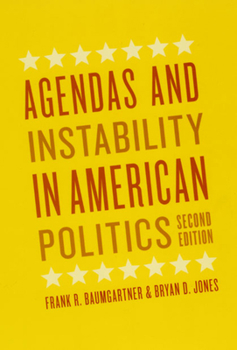Agendas and Instability in American Politics, Second Edition
(Part of the Chicago Studies in American Politics Series)
Select Format
Select Condition 
Book Overview
When Agendas and Instability in American Politics appeared fifteen years ago, offering a profoundly original account of how policy issues rise and fall on the national agenda, the Journal of Politics predicted that it would "become a landmark study of public policy making and American politics." That prediction proved true and, in this long-awaited second edition, Bryan Jones and Frank Baumgartner refine their influential argument...
Format:Paperback
Language:English
ISBN:0226039498
ISBN13:9780226039497
Release Date:May 2009
Publisher:University of Chicago Press
Length:368 Pages
Weight:1.05 lbs.
Dimensions:1.0" x 6.0" x 8.8"
Customer Reviews
2 ratings
Nice analysis of policy change
Published by Thriftbooks.com User , 17 years ago
Frank Baumgartner and Bryan Jones have written an imaginative and important work on the rhythm of the policy process. Their thesis is straightforward: policy often moves in cycles of stasis (relative stability in the policy arena) over a period of time, followed by a fairly rapid burst of change. Using the language of the evolutionary argument by Niles Eldredge and Stephen Jay Gould, they refer to their model as "punctuated equilibrium." Eldredge and Gould posted that evolutionary change was often characterized by long periods of stasis (or stability) in a species, followed by a dramatic burst of rapid change (in evolutionary terms). Baumgartner and Jones do not leave it at that. Merely describing a pattern that they see in different arenas over time is only a first step. How to explain such change? The authors provide a reasonably convincing argument: One, institutions produce a considerable degree of stability; two, particular policy "images" shape debate and constrain change over periods of time. However, institutions cannot forever prevent change. And policy images can change. As new views come into the policy debate, this can lead to a breakdown of the old "order" and punctuational (rapid) change. The book provide some examples of this, such as budgetary change (and see Baumgartner and Jones' edited volume, "Policy Dynamics," for an even broader range of examples of the theory in operation). If one is interested in the dynamics of policy change, then "Agendas and Instability in American Politics" is a good book to look at. It is not the only approach to explaining policy change (e.g., see Paul Sabatier's work for another effort to explain stasis and change), but it is a rich perspective and has seen a number of applications.
Studying Issue Change in the Long-Term
Published by Thriftbooks.com User , 18 years ago
Baumgartner and Jones argue that in the agenda setting stage of public policymaking, issue changes may occur through two distinctly different, yet not mutually exclusive processes. First, the authors argue that issue changes may occur incrementally in which changes to policy arise smoothly and appear at the margins of policymaking. Such a process is closely related to Lindblom's "muddling through." Second, the authors move away from the incremental approach and argue that a second process may describe agenda setting. Issue changes may, at times, occur quite dramatically. The second process espoused by Baumgartner and Jones is related, in part, to Kingdon's Multiple Streams approach. Baumgartner and Jones attempt to explain both the incremental and dramatic issue changes which occur in the policymaking process through a single paradigm, the Punctuated-Equilibrium Theory (PT). The Punctuated-Equilibrium Theory seeks to explain both the general stability and the occasional upheaval of the agenda setting stage of the policy process. According to the Punctuated-Equilibrium Theory, both stability and radical change which accompany the agenda setting process are the result of the interaction between subsystem politics (i.e. issue networks, iron triangles) and the macropolitical arena - for example, the United States Congress. Most issues which may potentially appear on the agenda are handled quietly by experts through iron triangles or issue networks. In these areas, issue change is often subtle and incremental. However, issues may enter the macropolitical arena and then the issue may "catch fire, dominate the agenda, and result in changes in one or more subsystems." As such, it can be argued that the subsystems in politics are representative of the generally stable aspects of the agenda setting process, while the macropolitical arena represents the more dramatic changes in agenda setting. The subsystems of politics illustrate the stable side of agenda setting because most subsystems are composed of policy monopolies. A policy monopoly occurs when the subsystem is dominated by a single interest supported by a powerful policy image. Baumgartner et al. write, "Because a successful policy monopoly systematically dampens pressure for change, we say that it contains a negative feedback process. Still, policy monopolies can change." They way in which these policy monopoly's change is by succumbing to outside pressures. If pressures increase to a sufficient point, previously detached political actors may become drawn in and force changes, or as Baumgartner and Jones may say, punctuate the equilibrium. In order to illustrate their hypothesis that the agenda setting process is composed of both periods of stability and upheaval, Baumgartner and Jones examine the issue life of a number of pressing policy arenas: civilian nuclear energy, urban planning, smoking regulation, and others. Through a combination of both quantitative and qualitativ





